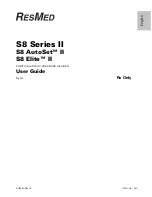
What is it for?
The T-rack is designed to mobilise your
thoracic spine, the portion of your spine
that has the ribs attached to it. This por-
tion of your spine is the most immobile.
Stiffness in this region puts undue load
onto the other portions of your spine and
furthermore to your shoulder girdle and
pelvic girdles. Hence, when it becomes
stiff, it causes discomfort and eventually
pain to many areas of your body, includ-
ing your lower back, neck and even caus-
ing headaches.
Mobilising this area is time dependant.
What does this mean? The type of tissue
that becomes stiff (the connective tissues
about the joints) need to be stretched for
prolonged periods to become mobile.
Small time frame stretches will only make
changes for brief periods. Hence, the T-
rack is made for you to rest on for min-
utes to achieve this goal.
What type of conditions should
I use it for?
The T-rack is designed for stiff thoracic
spines (middle of your back—ribs at-
tached). Because this area of your spine
can contribute to so many painful condi-
tions, there are numerous conditions that
can be treated. Postural headaches,
shoulder immobility (stiffness), neck pain
and stiffness, nerve related arm pain and
many more conditions.
The T-rack is also excellent for perform-
ance enhancement for athletes. Mobility
of your thoracic spine is highly desirable
for many sports including, swimming,
triathlon, tennis, cricket bowling, and any
other activity where overhead activities
are needed.
Why the two raised curves?
The boney portion of your spine should
not be placed on hard surfaces for obvi-
ous reasons, hence the T-rack is de-
signed so that the exposed boney por-
tion of your spine sits in between the
two raised curves.
Why that angle?
Research into the thoracic spine indi-
cated that the angle of the rack was the
optimal angle of extension necessary
for ‘normal’ movement capabilities.
Why the hard surface?
Soft surfaces such as a Swiss Ball will
conform to your spine. Hence if your
Thoracic spine is stiff then the ball will
simply conform to this stiffness—not
mobilizing it. Moreover, the already
hypermobile (very flexiible ) portions of
your spine will do all the mobility, fur-
ther loading this area, eventually caus-
ing pain or injury.
Therefore the surface needs to be hard
so that the stiff portions of your spine
will have to conform to the shape of the
rack, and hence mobilise them.
Why the head rest?
There are two reasons for the head
rest. Firstly, everyone's back is a differ-
ent length. By sliding the head rest you
can adjust the rack to your length back.
Secondly, it is important to avoid put-
ting your neck into too much extension
(back of your head going towards your
back—looking up) as this position can
compress important soft tissue struc-
tures at the base of your spine. Hence,
the very back of your head sits flush on
the head rest to avoid this extension of
your cervical spine (neck).
Instructions for use
Using the T-Rack
The T-rack is only to be
used for conditions that are
of a non traumatic nature.
Anyone who has pain that
has been caused by an ac-
cident or any trauma
should first consult their
health Practioner before
use of the T-rack.
Any person who is suffering
from Chronic disease, such
as Osteoporosis, should
first consult their health
practitioner before using
the T-rack.
The T-rack is only to be
used as the directions sug-
gest.
Read Before Use
Poor posture
Good posture
Stiff Thoracic
Spine
Mobile
Thoracic
Spine
Stiff Thoracic
Spine




















